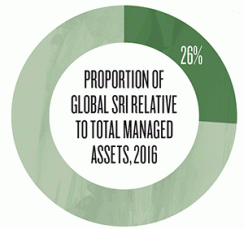Click her to download a PDF of this report.
From 2014 to 2016, Japan’s socially responsible investments grew at an astonishing rate, rising from a mere $7 billion to $474 billion, by far the fastest pace of expansion in the developed world.
These figures are partly due to better measurement, as the Japan Sustainable Investment Forum queried institutional asset managers on their use of SRI strategies for the first time during this period. But this growth clearly illustrates a dramatic change in the way that Japanese investors view ESG (environmental, social, and governance) screening and other SRI strategies.
In 2015, Japan’s largest pension fund, the GPIF, signed the UN Principles for Responsible Investing, and immediately allocated 3 percent of its $1.3 trillion in assets under management to sustainable strategies. The fund pledges to increase its allocation to SRI investments to 10 percent over time.
Asia has long lagged behind the U.S. and Europe in applying ESG analysis and standards to portfolio holdings, focusing instead on traditional financial research. The region has less than 1 percent of its total assets invested in SRI assets, according to the Global Sustainable Investment Alliance’s 2016 Global Sustainable Investment Review, compared to over half of allocations in Europe (52.6%), more than a third in Canada (38.8%) and over a fifth in the United States (21.6%). Asia has, in total, only about $52 billion in assets managed according to some type of SRI strategy — a category that includes nearly $20 billion in assets managed according to Sharia principles, rather than more conventional ESG strategies. But with the emergence of Japan as an ESG powerhouse, and the increasing commitment of China to green finance, sustainable investment is rapidly expanding in Asia.
Gaining momentum after a slow start
ESG has been slow to take root in Asia, where investors have historically focused on financial performance rather than social or environmental impact, but this is changing. Paul Milon, ESG integration and Sustainability Investment Specialist at BNP Paribas Asset Management, says this shift is supported by a number of studies that have shown a positive relationship between ESG and financial performance in Asia, and especially its emerging markets. A 2015 article in the Journal of Sustainable Finance & Investment, “ESG and Financial Performance: Aggregated Evidence from More Than 2,000 Empirical Studies,” made a particularly compelling case. The study showed that “EM [emerging markets] had both the highest percentage [65.4 percent] of studies showing a positive correlation between ESG and financial returns, and the lowest percentage [5.8 percent] of studies showing a negative correlation,” says Milon.
China’s green finance push
Outside Japan, ESG investing is just getting started, but China has taken a leadership role by building financing infrastructure to support its vast drive toward sustainability. China is expected to invest $2.2 trillion in sectors including renewable power, waste and water management, and pollution control through 2020, according to energy consultants ENEA.
Investment markets are also evolving to finance this renewables boom. In equities, for instance, the S&P 500 New China Index focuses on new-economy companies in health care, technology and consumer goods — a vastly different segment than the old industrial companies that comprise more established indexes like the Hang Seng. The China Green Basket is even more focused, investing in a pool of 26 companies in the environmental protection and clean energy industries. A range of ESG-focused China funds and ETFs has sprung up, as well.
At the same time, China has emerged as the world’s largest issuer of climate-aligned bonds, according to CBI, with $220 billion in issuances. The country is now in the process of developing a labeled green bond market.

Governance is the next big hurdle
Governance issues are also receiving increasing attention, as investors begin to demand a higher degree of transparency, accountability and board independence from Asian companies. This is a fairly recent development, explains Jonah Sulaeman, Academic Director of the MSc (Finance) Program at the National University of Singapore Business School. “Asian firms tend to be more opaque relative to their American or European counterparts. Concerns regarding potential misappropriation can be more severe in Asia due to ownership structures that primarily involve family firms and business groups controlled by prominent families,” he says.
Milon concurs that governance is complicated by ownership structures. “In Japan and South Korea, the traditional conglomerate structures, with cross-shareholding between entities, mean that investors need to be mindful of potential conflicts of interest that may arise. In China and India, most listed companies have a de facto controlling shareholder, which means investors need to pay particular attention to the respect of minority shareholders or related party transactions.”
Yet even against this backdrop, change has begun. Milon notes that in 2017 alone, countries including Japan, South Korea, Malaysia and Thailand have adopted new or revised stewardship codes or corporate governance codes.
ESG is reshaping companies and industries
Heightened focus on ESG issues puts companies like CapitaLand, one of Asia’s largest real estate companies, in the sustainability spotlight. CapitaLand, based in Singapore, manages a $64 billion global portfolio of integrated developments, shopping malls, serviced residences, offices, homes, real estate investment trusts (REITs), and funds in over 30 countries.
“As one of Asia’s largest real estate developers, we believe in growing our business in a sustainable manner to create long-term value for our investors and improve the economic and social well-being of our communities,” reads CapitaLand’s mission statement. “We are committed to improving the economic, environmental and social well-being of our stakeholders through our projects and operations management. We embrace innovation to ensure our commercial viability without compromising the environment for future generations.”
Kasikorn Bank, in Thailand, has also made sustainable business practices a centerpiece of its strategy. Through its Green DNA initiative, the bank pursues sustainable development of the economy, society, and environment as a central building block of its organizational culture. In 2017, Kasikorn became the first Asian bank to be included in the Dow Jones Sustainability Index.
An evolving commitment
As ESG takes hold in Asia, it is evolving to meet the unique characteristics of Asian markets and economies. Investors and corporate management are not simply mirroring what has been done in Europe and the Americas, but putting their own stamp on sustainability. “The main difference between Asia versus the rest of the world is how ESG is incorporated into investment decisions,” says Sulaeman. “In the global market, negative screening is frequently employed, in which stocks with negative ESG performance are excluded from the investment universe. In contrast, Asian investors are less rigid, and typically include ESG factors as part of the investment process, in which ESG performance is integrated with other investment considerations.”
“ESG has a much longer history in Europe and the U.S., so there is still a lot of investor education needed in Asia,” says Milon. “An area where we have been successful in promoting ESG investing to Asian investors is our thematic strategies, aiming to help address sustainability issues such as water, sustainable food, or climate change. For these thematic strategies, Asian investors can more clearly see how they can combine doing good — by addressing serious sustainability challenges — and doing well, by investing in businesses seizing promising environment-related business opportunities.” — Jennifer Kelly
Delivering Value Through ESG Investing
With new regulatory requirements in environmental, social, and governance (ESG) disclosures, coupled with Asia’s transition to become a low carbon region, sustainability investing in Asia is set to gain more prominence, and continue attracting capital to finance Asia’s economic growth. A focus on ESG may seemingly be at odds with profitability, but the two goals need not be mutually exclusive.
CapitaLand Limited, one of Asia’s largest real estate companies certainly believes so. Mr. Tan Seng Chai, Group Chief People Officer of CapitaLand Limited and Chairman of the CapitaLand Sustainability Steering Committee, says, “Guided by our credo ‘Building People. Building Communities.’, we want to build a lasting company that adds value to our stakeholders across our diversified global real estate portfolio. We take a proactive and holistic approach that integrates sustainability into our policies, structure, management, and operations.”
A strong advocate of transparency, the publicly listed company was also one of the first companies in Singapore to voluntarily publish its first annual sustainability report, in 2009, prior to the guidelines and requirements issued by the Singapore Exchange.
CapitaLand’s persistent drive for operational efficiency in energy and water consumption has amounted to utilities cost avoidance for the Group in excess of S$108 million through FY 2016 since 2009. For example, in China, the upgraded water fixtures and meters in the company’s integrated developments, such as Raffles City Beijing and Raffles City Shanghai, have helped to achieve an estimated utility savings of S$72,000 annually. The two buildings are Leadership in Energy and Environmental Design (LEED) Gold certified.
The company has also recently been recognized as the world’s most sustainable corporation in real estate development and management in the 2018 Global 100 Most Sustainable Corporations in the World rankings.
Increasingly, savvy investors also recognize the interdependence between the community and business.
“We recognize that the long-term success of our business is closely linked with the health and prosperity of the communities we operate in,” shares Mr. Tan. Every year, CapitaLand allocates up to 0.5% of its net profit to CapitaLand Hope Foundation, the philanthropic arm of CapitaLand, to promote social growth and development of underprivileged children with respect to their education, healthcare, and shelter needs. Mr. Tan is also the Executive Director for CapitaLand Hope Foundation.
The company is also a strong advocate for volunteerism. In 2006, CapitaLand was one of the first companies to formalize three days of Volunteer Service Leave for its staff. This has helped create a positive and vibrant corporate culture, improving staff recruitment and retention. Based on post-volunteer surveys, more than 87% of staff volunteers feel proud and enjoy working at CapitaLand.
To enhance long-term returns and reduce risks, CapitaLand also upholds high standards of corporate governance to safeguard shareholders’ interest, and enhance business resilience and agility. With a robust enterprise risk management framework in place, the company’s employee code of business conduct, a bribery and corruption prevention policy, and a whistle-blowing policy further safeguard the company against external risks.
Taking a broader view, Mr. Tan adds, “To build a trusted and respected business enterprise, CapitaLand not only requires a belief in strong corporate governance, but also in being transparent, having open communications, and continually engaging our stakeholders.”






